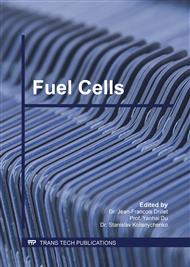[1]
J. Qian, Z. Tao, J. Xiao, G. Jiang, W. Liu, Performance improvement of ceria-based solid oxide fuel cells with yttria-stabilized zirconia as an electronic blocking layer by pulsed laser deposition, Int. J. Hydrogen Energy, 38 (2013) 2407.
DOI: 10.1016/j.ijhydene.2012.11.112
Google Scholar
[2]
A. Midilli, U. Akbulut, I. Dincer, A parametric study on exergetic performance of a YSZ electrolyte supported SOFC stack, International Journal of Exergy, 24 (2017) 173.
DOI: 10.1504/ijex.2017.10008595
Google Scholar
[3]
B. C. Steele, A. Heinzel, Materials for fuel-cell technologies, Nature, 414 (2001) 345.
Google Scholar
[4]
F. M. L. Figueiredo, F. M. B. Marques, Electrolytes for solid oxide fuel cells, Wires. Energy Environ., 2 (2013) 52.
Google Scholar
[5]
E. D. Wachsman, K. T. Lee, Lowering the temperature of solid oxide fuel cells, Science, 334 (2011) 935.
DOI: 10.1126/science.1204090
Google Scholar
[6]
L. H. Luo, Y. Lang, Z. Z. Huang, L. Cheng, J. J. Shi, Fabrication of YSZ film by aqueous tape casting using PVA-B1070 cobinder for IT-SOFC, Key Eng. Mater., 434 (2010) 735.
DOI: 10.4028/www.scientific.net/kem.434-435.735
Google Scholar
[7]
R. O'hayre, S.-W. Cha, F. B. Prinz, W. Colella, Fuel cell fundamentals, third ed, John Wiley & Sons, (2016).
Google Scholar
[8]
H. Tuller, A. Nowick, Doped ceria as a solid oxide electrolyte, J. Electrochem. Soc., 122 (1975) 255.
DOI: 10.1149/1.2134190
Google Scholar
[9]
W. Liu, B. Li, H. Liu, W. Pan, Electrical conductivity of textured Sm3+ and Nd3+ Co-doped CeO2 thin-film electrolyte, Electrochim. Acta, 56 (2011) 3334.
DOI: 10.1016/j.electacta.2011.01.018
Google Scholar
[10]
Y. Liu, B. Li, X. Wei, W. Pan, Citric-Nitrate Combustion Synthesis and Electrical Conductivity of the Sm3+ and Nd3+ Co-Doped Ceria Electrolyte, J. Am. Ceram. Soc., 91 (2008) 3926.
DOI: 10.1111/j.1551-2916.2008.02748.x
Google Scholar
[11]
Y. C. Wu, C. C. Lin, The microstructures and property analysis of aliovalent cations (Sm3+, Mg2+, Ca2+, Sr2+, Ba2+) co-doped ceria-base electrolytes after an aging treatment, Int. J. Hydrogen Energy, 39 (2014) 7988.
DOI: 10.1016/j.ijhydene.2014.03.063
Google Scholar
[12]
R. t. Shannon, Revised effective ionic radii and systematic studies of interatomic distances in halides and chalcogenides, Acta Crystallogr. A, 32 (1976) 751.
DOI: 10.1107/s0567739476001551
Google Scholar
[13]
Z. Fu, Q. Sun, D. Ma, N. Zhang, Y. An, Z. Yang, Effects of Sm doping content on the ionic conduction of CeO2 in SOFCs from first principles, Appl. Phys. Lett., 111 (2017) 023903.
DOI: 10.1063/1.4993897
Google Scholar
[14]
K. Eguchi, T. Setoguchi, T. Inoue, H. Arai, Electrical properties of ceria-based oxides and their application to solid oxide fuel cells, Solid State Ionics, 52 (1992) 165.
DOI: 10.1016/0167-2738(92)90102-u
Google Scholar
[15]
S. H. Chan, X. J. Chen, K. A. Khor, A simple bilayer electrolyte model for solid oxide fuel cells, Solid State Ionics, 158 (2003) 29.
DOI: 10.1016/s0167-2738(02)00758-0
Google Scholar
[16]
H. T. Lim, A. V. Virkar, Measurement of oxygen chemical potential in Gd2O3-doped ceria-Y2O3-stabilized zirconia bi-layer electrolyte, anode-supported solid oxide fuel cells, J. Power Sources, 192 (2009) 267.
DOI: 10.1016/j.jpowsour.2009.03.035
Google Scholar
[17]
A. Tsoga, A. Gupta, A. Naoumidis, D. Skarmoutsos, P. Nikolopoulos, Performance of a double-layer CGO/YSZ electrolyte for solid oxide fuel cells, Ionics, 4 (1998) 234.
DOI: 10.1007/bf02375951
Google Scholar
[18]
Y. C. Wang, Z. Y. Fu, W. M. Wang, Numerical Simulation of the Temperature Field in Sintering of BN by SPS, Key Eng. Mater., 249 (2003) 471.
DOI: 10.4028/www.scientific.net/kem.249.471
Google Scholar
[19]
Z. Munir, U. Anselmi-Tamburini, M. Ohyanagi, The effect of electric field and pressure on the synthesis and consolidation of materials: A review of the spark plasma sintering method, Journal of Materials Science, 41 (2006) 763.
DOI: 10.1007/s10853-006-6555-2
Google Scholar
[20]
X. Chen, K. Khor, S. Chan, L. Yu, Overcoming the effect of contaminant in solid oxide fuel cell (SOFC) electrolyte: spark plasma sintering (SPS) of 0.5 wt.% silica-doped yttria-stabilized zirconia (YSZ), Materials Science and Engineering: A, 374 (2004).
DOI: 10.1016/j.msea.2003.12.028
Google Scholar
[21]
L. A. Chick, L. R. Pederson, G. D. Maupin, J. L. Bates, L. E. Thomas, G. J. Exarhos, Glycine-nitrate combustion synthesis of oxide ceramic powders, Mater. Lett., 10 (1990) 6.
DOI: 10.1016/0167-577x(90)90003-5
Google Scholar
[22]
V. Singh, S. Babu, A. S. Karakoti, A. Agarwal, S. Seal, Effect of submicron grains on ionic conductivity of nanocrystalline doped ceria, J Nanosci. Nanotech., 10 (2010) 6495.
DOI: 10.1166/jnn.2010.2523
Google Scholar
[23]
A. Tsoga, A. Naoumidis, A. Gupta, D. Stöver, Microstructure and interdiffusion phenomena in YSZ-CGO composite electrolyte, Mater. Sci. Forum, 308 (1999) 794.
DOI: 10.4028/www.scientific.net/msf.308-311.794
Google Scholar



